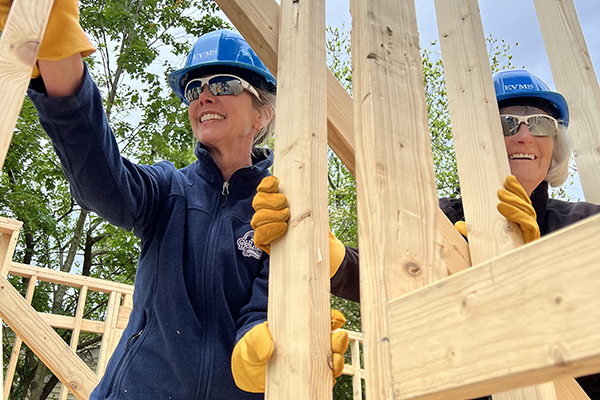
By Laurie Harrison, president of the Rotary Club of Norfolk, Virginia, USA
Prior to May 2023, my main construction experience consisted of building an Adirondack chair 28 years ago for a Father’s Day gift.
But there I was at a Habitat for Humanity Southeastern Virginia construction site, wearing a blue hard hat and safety goggles as I carefully ran boards through a table saw. I passed the boards to other female Rotarians helping to build a house.
Kudos go to Rotary International President Jennifer E. Jones for inspiring my foray into home construction. Hearing our first female international president speak last summer at the Rotary International Convention in Houston made me ponder ways to empower other women in my club.
I’m the ninth female president of the 109-year-old Rotary Club of Norfolk, which is 70% male. I’m happy that the men and women in our club frequently work side-by-side to benefit our area food bank and other key nonprofits. And yet, inspired by Jennifer, I longed for a tangible service project led by women. Habitat’s third-annual Women Build project in southeastern Virginia was the perfect opportunity to engage female Rotarians.
Inviting Habitat’s executive director to speak at a club meeting led to us awarding a $5,000 club grant for the Women Build project in nearby Chesapeake, Virginia. Our speaker stressed that home ownership gives families stability, which leads to adults engaged in their communities and children succeeding in school and life. Since 1988, Habitat volunteers have constructed 243 homes for lower-income families in southeastern Virginia. One house each year is usually built by women.
After Habitat selected our club for the 2023 Women Build project, I recruited a team including current and past Rotary board members, one new Rotarian, and my identical twin sister (a Rotary spouse). Our ages spanned several decades. The group included current and retired professionals, a working mother of two toddlers, and grandmothers. We had little to no construction experience but were eager to learn and help.
The eight of us were among 200 Virginia women working in teams to successfully build a four-bedroom, 1,500-square-foot house in 12 days. Like all Habitat homeowners, our recipient family is donating at least 200 hours of sweat equity to Habitat and is responsible for paying off an affordable home mortgage.
The family moving into our house is headed by a couple who emigrated to Virginia from Morocco 10 years ago and became U.S. citizens. The husband works at a shipyard while his wife studies cybersecurity at a local community college. The family lives in a cramped, two-bedroom apartment with their 8-year-old son and 6-year-old daughter. Soon, they will move and welcome a baby to their spacious new home.
As the mom of three children, I understand the parents’ excitement about owning a new home with plenty of room for their growing family to spread out and thrive.
During construction, our Rotary team experienced all of coastal Virginia’s spring weather – cold, rain, wind, heat, and sunshine. But, with a deadline looming, our work never stopped. We started with a safety briefing and divided into teams of two and three. Each team had an experienced Habitat volunteer teach us to accurately measure boards, safely cut them to the right lengths, and use nail guns to secure them to a frame. After our training, the experienced volunteers stepped back and let us do our jobs.
We worked seamlessly, supporting each other as we measured, sawed, and nailed. Our group ended up feeling energized despite hoisting heavy boards and pounding nails with nail guns that weighed more than I would have guessed. We learned new skills, got to know each other better, and put Service Above Self into action.
Now I’m back to my normal work at Eastern Virginia Medical School in Norfolk. As director of community engagement, the main tool I wield is a computer. But I relish my Habitat construction experience and thank Jennifer Jones for all she does for Rotary International – and for being my role model.
Maybe it’s time to build another Adirondack chair.
Rotary International’s service partnership with Habitat for Humanity International helps clubs and districts empower local communities through access to technical expertise and volunteer service opportunities related to safe and affordable housing, water and sanitation facilities and hygienic practices, disaster response, and community economic development. Contact your local Habitat to develop and implement local service projects.
https://blog.rotary.org/2023/06/15/all-female-crew-builds-a-home-with-habitat-for-humanity/
